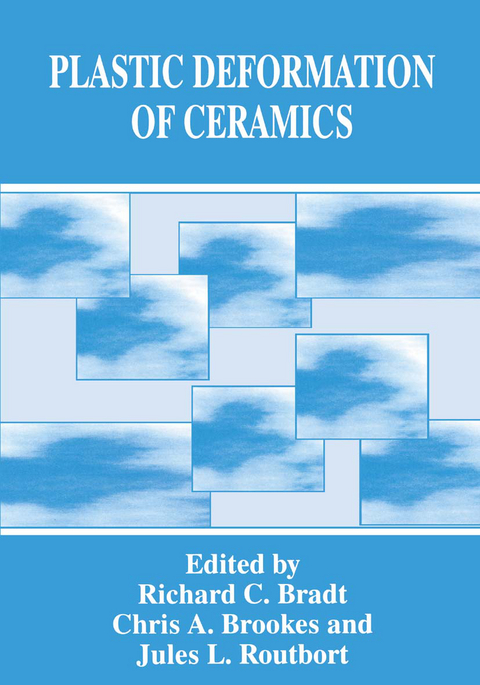
Plastic Deformation of Ceramics
Springer-Verlag New York Inc.
978-1-4899-1443-9 (ISBN)
This proceedings volume, "Plastic Deformation of Ceramics," constitutes the papers of an international symposium held at Snowbird, Utah from August 7-12, 1994. It was attended by nearly 100 scientists and engineers from more than a dozen countries representing academia, national laboratories, and industry. Two previous conferences on this topic were held at The Pennsylvania State University in 1974 and 1983. Therefore, the last major international conference focusing on the deformation of ceramic materials was held more than a decade ago. Since the early 1980s, ceramic materials have progressed through an evolutionary period of development and advancement. They are now under consideration for applications in engineering structures. The contents of the previous conferences indicate that considerable effort was directed towards a basic understanding of deformation processes in covalently bonded or simple oxide ceramics. However, now, more than a decade later, the focus has completely shifted. In particular, the drive for more efficient heat engines has resulted in the development of silicon-based ceramics and composite ceramics. The discovery of high-temperature cupric oxide-based superconductors has created a plethora of interesting perovskite-Iike structured ceramics. Additionally, nanophase ceramics, ceramic thin films, and various forms of toughened ceramics have potential applications and, hence, their deformation has been investigated. Finally, new and exciting areas of research have attracted interest since 1983, including fatigue, nanoindentation techniques, and superplasticity.
Crack-Tip Plasticity and Quasi-Brittle Fracture of Single Crystals.- The Brittle to Ductile Transition in MgAl2O4 Spinel.- Plasticity of Zirconia.- Plastic Deformation of Zirconia Single Crystals by in situ Straining Experiments in an HVEM at 1150°C.- Dislocation Decomposition, Dissociation, and Deformation in MoSi2 and ?-Al2O3 Single Crystals.- Basal Slip and Twinning in Sapphire (?-Al2O3).- Dislocation Dissociation in Chain Silicates.- Anelastic Behavior of Silicate Glass-Ceramics and Partial Melts: Migration of the Amorphous Phase.- Deformation Studies of Quasicrystals.- Deformation of Nonstoichiometric CuO Polycrystals.- Plastic Deformation of Bulk YBaCuO Ceramics Doped with ZrO2.- Impression Plasticity and Creep in Hard Crystals.- Deformation of Advanced Materials: Case of Sapphire Modified by Heavy Ion Implantation and of YBCO Superconducting Crystals.- Spherical Indentation as a Means for Investigating the Plastic Deformation of Ceramics.- The Nanoindentation Response of Silicon and Related Structurally Similar Materials.- Investigation of Depth-Area Relationships Associated with Nanoindentations.- “Nano” and “Micro” Hardnesses of Single Crystal Yttrium Aluminum Garnet (YAG) on the{111} Plane.- Deformation of Thin Ceramic Films Designed for Electronic Applications.- Apparent Indentation Plasticity in Ceramic Coated Systems.- Hardness Change of Nonstoichiometric MgO.3Al2O3 by Neutron Irradiation.- The Cumulative Deformation, Work-Hardening and Fracture of Magnesium Oxide at Room Temperature, Under Repeated Point Loading Conditions.- The Characteristics of Superplastic—like Flow in Ceramics.- Solution-Precipitation Creep Model for Superplastic Ceramics with Intergranular Liquid Film.- A Granular Flow Approach to Fine-Grain Superplasticity.- CreepDeformation of Nanocrystalline Oxides.- Characterization of High-Temperature Superplasticity in Fine-Grained Zirconia Polycrystals.- A Quantitative Analysis of Cavity Formation in Superplastic Yttria-Stabilized Tetragonal Zirconia.- Superplastic Deformation of CuO-Doped 3Y-TZP.- Superplastic Forming of Zirconia.- Superplastic Deformation of Zirconia/Alumina Composites Produced by Reaction Bonding.- Enhanced Ductility of High-Purity Polycrystalline Yttria.- Superplastic Deformation of a Monolithic Silicon Nitride.- Creep Mechanisms in Multiphase Ceramics.- High-Temperature Deformation Mechanisms in Ceramic Materials.- Creep Recovery Mechanisms.- Deformation of High-Temperature Superconductors.- Stable Dislocation Configurations in YBa2Cu3O7-?.- Creep Behavior of Cation Solid Solution Alloys.- Kinetics and Mechanisms of Constant Stress Creep in the Non-Oxide Ceramics of SiC, SiC-Whisker-Reinforced Si3N4 Composites and AlN.- Dislocation Mechanisms in Alpha SiC Deformed at High Temperature.- Evolution of Oxidation and Creep Damage Mechanisms in HIPed Silicon Nitride Materials.- Bend Stress Relaxation and Tensile Primary Creep of Polycrystalline ?-SiC Fiber.- Importance of Cavitation to the Creep of Structural Ceramics.- The Role of Grain Boundary Sliding on Creep Deformation Characteristics of Discontinuous Reinforced Composites.- High-Temperature Deformation of Dual Phase Alumina-Zirconia Composites.- Tensile Creep of Alumina and SiC Whisker-Reinforced Alumina.- Plastic Deformation of Alumina Reinforced with SiC Whiskers.- Creep Behavior in SiC Whisker-Reinforced Alumina Composite.- High-Temperature Creep Behavior of High-Purity Hot-Pressed Silicon Nitride.- Creep and Fatigue of SiC Fiber-Reinforced BMAS Glass-Ceramic Matrix Composites.- Morphology and DeformationCharacteristics of a CMC Based on a MLAS Vitroceramic Matrix.- Fatigue Crack Growth in Ceramics and Ceramic Composites at High Temperatures.- Mechanical Response of Ceramic Composites at Elevated Temperatures.- Issues for Creep and Rupture Evaluation of Ceramic Fibers.- Crack-Wake Plasticity and Time-Dependent Bridging During Subcriticai Crack Growth in CVI-SiC Reinforced with Nicalon Fibers.- Evaluation of Elevated-Temperature Crack Growth in Ceramics under Static and Cyclic Loads.- Effect of Grain Size on Fatigue Crack Growth in Silicon Nitride and Alumina.
| Zusatzinfo | XII, 671 p. |
|---|---|
| Verlagsort | New York |
| Sprache | englisch |
| Maße | 178 x 254 mm |
| Themenwelt | Naturwissenschaften ► Chemie ► Analytische Chemie |
| Naturwissenschaften ► Physik / Astronomie ► Atom- / Kern- / Molekularphysik | |
| Naturwissenschaften ► Physik / Astronomie ► Festkörperphysik | |
| Naturwissenschaften ► Physik / Astronomie ► Thermodynamik | |
| Technik ► Maschinenbau | |
| ISBN-10 | 1-4899-1443-9 / 1489914439 |
| ISBN-13 | 978-1-4899-1443-9 / 9781489914439 |
| Zustand | Neuware |
| Informationen gemäß Produktsicherheitsverordnung (GPSR) | |
| Haben Sie eine Frage zum Produkt? |
aus dem Bereich


